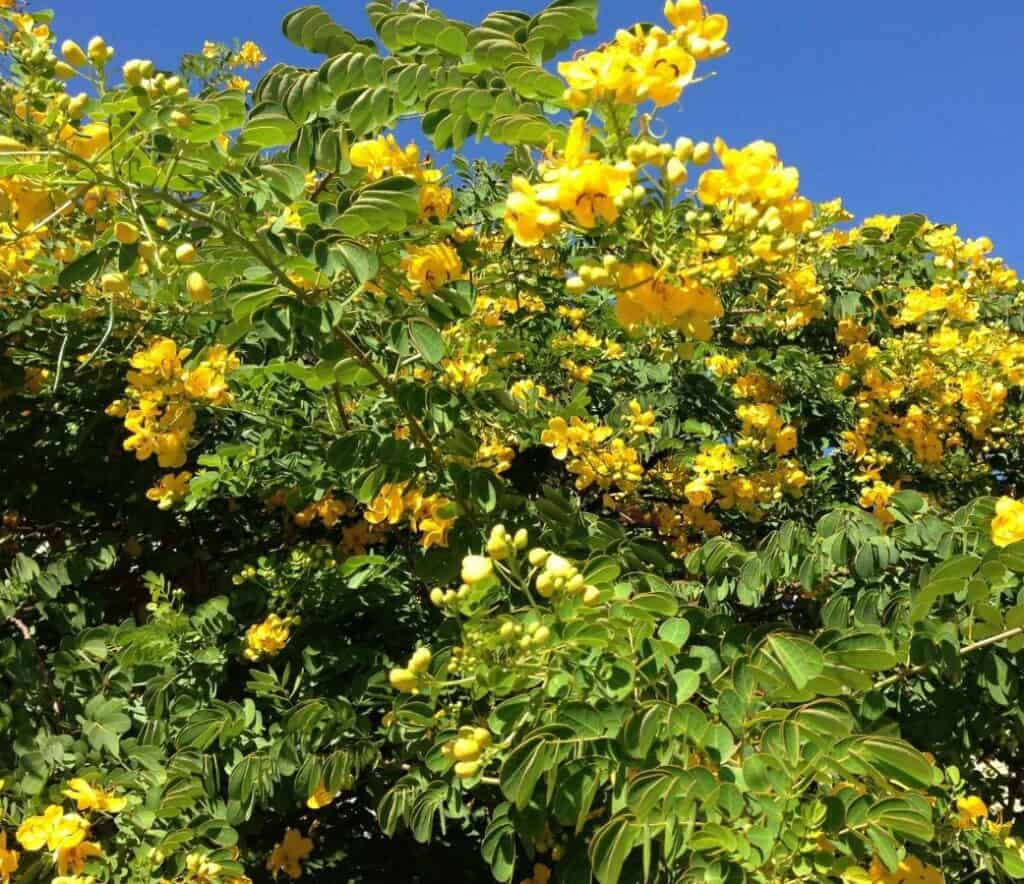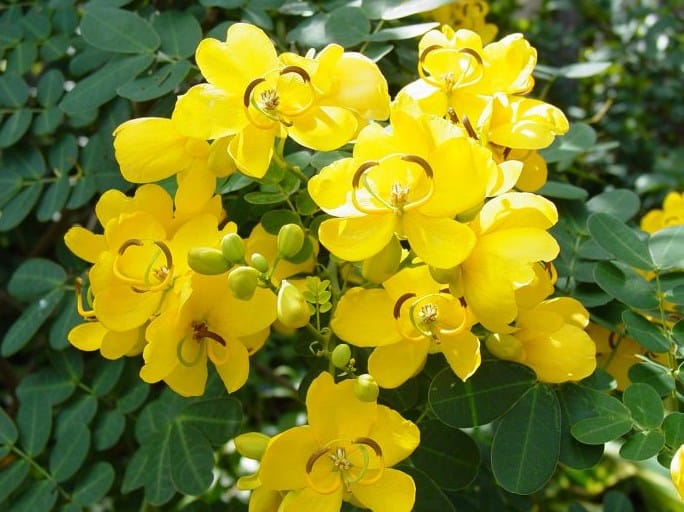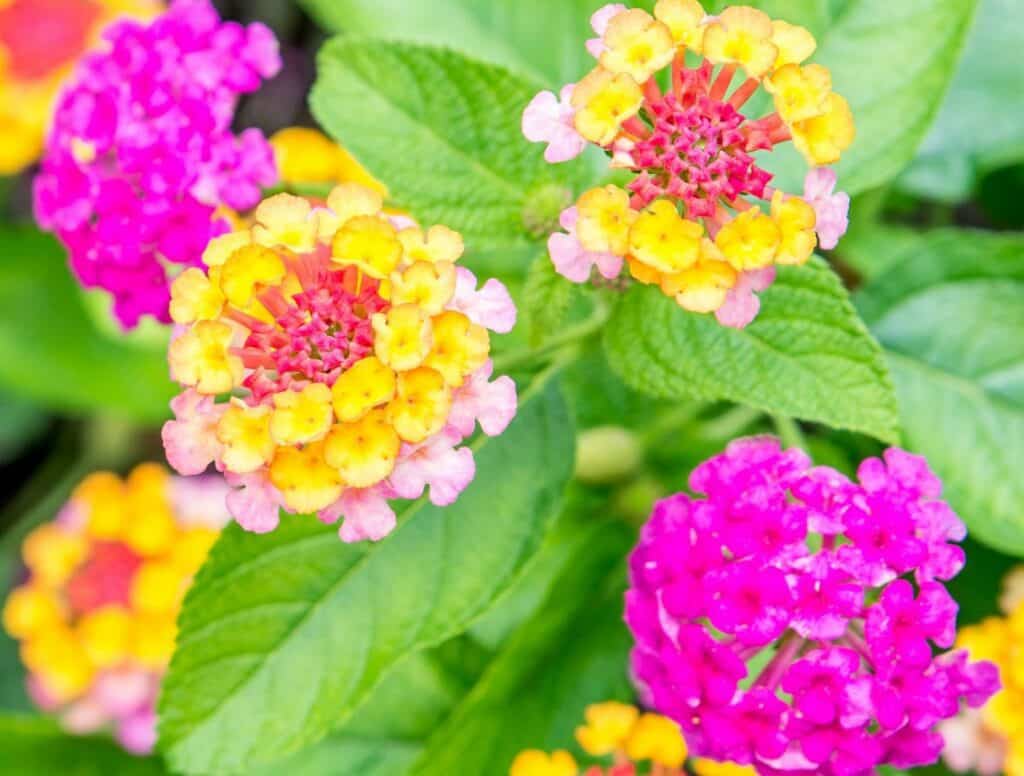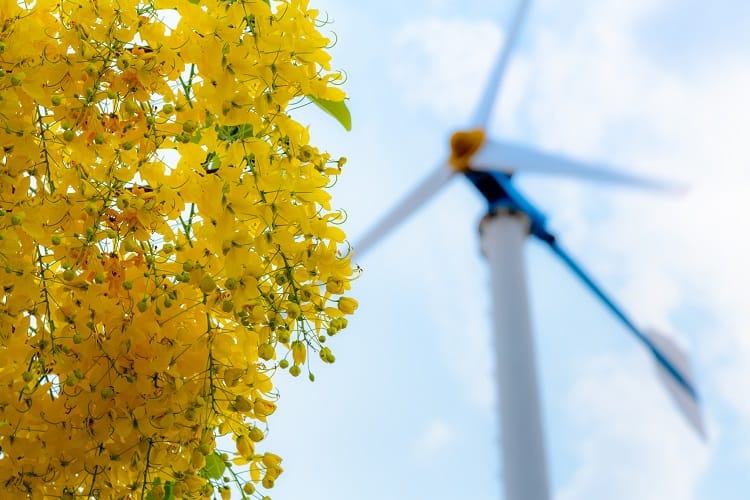- Cassia Tree (Cassia fistula): A Tropical Tree For Your Garden - January 27, 2022
- Camphor Tree (Cinnamomum Camphora) Info - November 18, 2021
- Japanese Lilac Tree: Why Is This Tree A Must Have For Your Garden? - November 7, 2021
Cassia fistula, also known as cassia tree, has many other names: Golden Shower Tree, Golden Shower, Shower Of Gold, Indian Laburnum, Purging Cassia, Rajah Kayu, Pudding Pipe Tree, Golden Rain Tree, Monkey-pod Tree, Bereksa, and Kasia Sena.
This tree has a special place in the Indian Subcontinent and Southeast Asia for its medicinal and ornamental value. So much so that it is the national flower in Thailand and the state flower for Kerala in India.
The species is native to the Indian subcontinent, but today you can find it throughout the tropical world. In the United States, you will find it growing in southern Florida and Hawaii. As a son of the tropics, roots in Florida and Jamaica, I always love sharing these types of trees with you.
I didn’t see many of these trees in central Florida, though I suspect that it is a bit too cold there. However, I’ve seen many throughout the Caribbean and sub-tropical East Asia.
Cassia tree offers an exotic and tropical touch to any landscape once you have the climate to support it. Before getting into the details, you should know that few trees in the world have more extravagant flower shows than this one. The immaculate and abundant bunches of fragrant yellow flowers that this tree produces each year indeed remains in the memory of anyone who witnesses it.
There are many species of cassia trees. Before getting into the details, remember that this article refers specifically to Cassia fistula.
How to Identify Cassia Tree
Growth Habit
Height: Quickly reaches 30 to 40 feet in less than five years. This is the mature height of the tree in most cases. Some report mature heights of 60 feet.
Spread: An equal spread of 30 to 40 feet
Crown uniformity: The crown is not uniform and has an irregular shape.
Crown shape: Vase, oval, upright/erect shape
Crown density: Moderate density
Growth rate: A vital feature of the cassia tree is how fast it grows. Within five years, you will have a mature tree. Some even report eight to 10 feet growth in the first year after planting by seed.
Foliage
The cassia tree has deciduous leaves. This fact may come as a surprise to you as most people associate deciduous trees with temperate climates and fall colors. However, many flowering tropical trees are deciduous, dropping their leaves in the spring before flowering.
In some tropical climates in the northern hemisphere, this happens at the heart of the dry season (March to May), right before the rainy season. The cassia tree is one of them.
Leaf arrangement: Alternate leaves
Leaf type: Compound; pairs of 4 to 8 leaflets
Leaf margin: Entire, undulate
Leaf shape: Oval
Leaf venation: Pinnate
Leaf-blade length: Leaflets are 3 to 6 inches; the entire compound is 12 to 18 inches
Leaf color: Green
Color before annual drop: Yellow
Flower
In most cases, the purpose of growing cassia or golden shower tree is for its showy yellow flowers. Though the flowers are only a couple of inches in diameter, there are so many clusters of them that it leaves a dramatic impact. Below are some quick facts about the flowers.
Flower color: A memorable and vibrant shade of yellow
Flower characteristics: Extremely showy flowers emerging in in clusters of eight to 10 inches long racemes
Flowering period: Cassia trees flower in spring to early summer in southern Florida and Hawaii, then in early fall. How reliable!
Fruit
Here is another interesting fact for you. Cassia tree is a legume belonging to the bean family, Fabaceae. Thus, they bear long pole bean pod-looking fruits after blooming.
Fruit shape: They look like pole bean pods. Fruits are elongated and cylindrical.
Fruit length: One to two feet
Fruit covering: Rough and hard
Fruit color: Pods start green and become black with maturity.
Fruit characteristics: The fruits do not attract birds or any other wildlife. They are showy. However, it can be messy looking as they all drop.
Trunk and Branches
Honestly, I don’t care much about the trunk and branches of this tree. I do not find anything interesting about them. The flower show is enough to grab my attention, so the rest seem to fall by the wayside in terms of interest. But, for the sake of thoroughness, here are some facts about them.
Trunk/branches: Branches are droopy; in most cases, one trunk
Bark: Branches are gray and smooth, and they become browner and rougher as the tree matures.
Pruning requirement: To encourage a strong structure, prune your cassia tree annually.
Breakage: Resistant to breakage, suitable for areas that experience strong winds.
Current year twig color: Brown
Current year twig thickness: Thick
Where Does Cassia Tree Grow
In the United States, there are only a few places where the Cassia tree will strive. Native to the Indian subcontinent, this tree has little to no cold weather tolerance. It will do fine in USDA hardiness zones 10B through 11. That’s pretty much the southernmost parts of Florida and the southern California coast. For your information, in zone 10b, the lowest temperature each year is between 35 to 40 degrees. Frost is extremely rare in these areas.
Uses of Cassia Tree
Landscape Use
In most cases, you will find cassia trees in lush tropical landscapes or as a street tree. Here are some quick ideas for bringing this tree to life if you are lucky enough to have a climate to grow it.
- Plant around the patio or near a pool.
- Use as a landscape accent around a circular driveway.
- Place it in a garden bed as an anchor.
- Plant cassia trees near pillars or similar structures to soften the straight lines and rigid angles.
- Plant as a border, adding color to a string of palm trees.
- Plant next to a fence or blank wall; it will make it much more vibrant.
If you are a fauna lover, you should know that the cassia tree attracts birds and serves as food to caterpillars and butterflies.
Medical Use
I will not recommend that you plant a cassia tree for medicinal purposes unless you know what you are doing and have significant familiarity with alternative medicine. Nevertheless, it is always interesting for plant enthusiasts like me to find out all the uses of plants and trees.
Almost all parts of the tree have medicinal properties. There is a long history of using the tree in Ayurvedic medicine in India. The tree treats ailments such as acne, burns, wounds, colds, and cancer. The seed pods and leaves are used to treat diabetes and liver problems. In addition, the pulp made from the seed pod has mild laxative properties.
Timber Use
Cassia tree wood is relatively strong. Many carpenters use it to make cabinets, wheels, posts, mortars, and firewood in Asia.
How to Grow Cassia Tree From Seed
Cassia trees are easy to grow from seed. This propagation method is ideal for home gardeners throughout the tropics because it grows easily and quickly. Here are some easy steps to get started indoors:
- In the fall, the pods with the seeds ripen. Collect a few pods and harvest the seeds inside.
- Scatter the seeds on a paper towel to dry them. Place the paper towel with the seeds in a plastic bag, seal it, and keep it in the fridge until you are ready to plant the seeds.
- In the winter, take the seeds out of the fridge. Then, use a sharp knife to punch a hole in the coat of each seed. Then, soak the punched seeds overnight in warm water.
- Get a shallow container and fill it with a peat potting mix. Peat has good moisture retention, which is necessary for this procedure. Make sure it has plenty of drainage soils. Water the soil until it is evenly moist.
- Once the soil is moist, plant the seeds two inches deep and cover them. Using a plastic sheet, cover the container to maintain the temperature of the soil.
- Find a sunny location where the temperate never falls below 75 degrees Fahrenheit. If the temperature is colder than this, germination may be slow or not happen at all. Place the covered container there.
- Remove the plastic cover when the seeds germinate.
- Water the soil regularly; it needs to remain moist.
- Once the seedlings get to about 2 inches high, plant each of them in their pot using the same peat potting mix. Once again, keep the soil moist.
- Take the container outdoors to harden the saplings once they are about four inches high. Each day gradually increase the amount of sunlight the saplings get.
- The cassia saplings should be ready to plant directly in the garden in early spring.
The above instructions are detailed and give your cassia tree seeds the best chance to germinate and grow. But I have a confession. In most tropical areas with year-round temperatures above 80 degrees and where this tree is expected, some people drop a seed or two in the garden and let nature take its course.
Cassia Tree Growing Conditions
Cassia trees do fine in chalky, loamy, and sandy soils. Provide your cassia tree with well-drained soil. If not, root rot is a risk. Regarding pH, cassia trees are flexible, doing fine in acid, alkaline, and neutral soils.
When to Plant Cassia Tree
You can plant cassia trees throughout the year.
How to Plant Cassia Tree
If you started your cassia tree saplings from seed or bought one, here are some instructions on how to plant it.
- Choose a spot that gets about six hours of direct sunlight. This requirement is non-negotiable.
- In loamy soil, dig a hole as deep as the sapling’s or young tree’s root ball twice the width.
- Gently remove the sapling from the pot. Check the roots to make sure they are well-formed and free of decay.
- Place the root ball in the hole.
- Fill the hole with soil and pack it to get rid of any air pockets. When the soil is firmly packed, the sapling should stand on its own.
- Water the soil and keep it moist during the first few months. But do not overwater.
Cassia Tree Water Requirements
Each week the cassia tree needs about two inches of water. In some areas with high rainfall, this is achievable. If the weather becomes scorching, the tree will need more moisture. Soak the soil surrounding the cassia tree about once a week to be safe. Wait until the topsoil dries out before watering it again as a rule of thumb.
Important note, cassia trees are not drought tolerant. Also, if the soil in your area dries out fast, water the tree twice a week.
Cassia Tree Sun Requirements
The cassia tree loves full sunlight. It should get at least six hours of full sun exposure every day. Sunlight is necessary to maintain its lush foliage and to promote blooming.
Without adequate sunlight or a temperature drop, the tree will start shedding leaves. Therefore, it is best to avoid planting next to a taller tree that may cast a shadow.
Best Cassia Tree Fertilizer
Any good 10-10-10 time-release fertilizer is suitable for your cassia tree. Feed it each spring following the manufacturer’s instructions.
Best Cassia Tree Companion Plantings
Consider planting near perennials. For great contrasting color, consider any of the following:
- Lantana
- Penta
- Blue daze and vinca
- Blueberry flax lily
Or the following groundcovers:
- Coral creeper
- Purple queen
- Sunshine mimosa
Cassia Tree Diseases and Common Problems
In most cases, the cassia tree attracts mildly severe pests such as aphids and whiteflies. You can quickly get rid of them with a garden hose. They will fall right off. However, consider using a natural substance such as neem oil on the leaves and the branches if the infestation is heavy.
Neem oil is an excellent pesticide. Alternatively, you can use insecticide soap. No matter the method, apply every three days or as the manufacturer directs.
Regarding diseases, the cassia tree isn’t prone to any major diseases that impact its growth or foliage. Unfortunately, root rot is possible. Root rot is generally a man-made problem caused by overwatering or planting the tree in poorly drained soil. Though cassia trees love moist soil, they will not strive with wet feet.
Cassia Tree Treatments and Maintenance
Pruning
Prune cassia trees when they are young to develop a uniform crown or create good structure. Young trees can have a grow asymmetrical growth pattern with branches drooping toward the grown.
Staking
Aside from punning, also consider staking saplings to encourage upright growth patterns.
Mulching
Cover the soil surrounding the tree with about two inches of mulch. Mulch helps retain moisture for this moisture-loving plant, especially in drought conditions. Also, mulch will help protect the roots if temperatures fall.
How to Remove Cassia Tree
Cassia is not a large tree. However, if your cassia is large, a professional tree cutter is the best way to go.
Here are some instructions on removing your cassia tree:
- The day before you plan to remove it, water the soil thoroughly. This will make the ground easier to dig.
- Measure the tree trunk. For every inch, plan to dig six inches deep to reach the root system.
- Once you determine the likely depth, dig around the tree’s roots. It will likely extend a bit wider than the outer edge of the tree’s canopy.
- Wiggle the root ball out using leverage.
- If you plan to transplant the tree, you can do so if the roots are intact. If you plan to get rid of it, cut it down with a chainsaw.
Overall, be sure to wear protective eyewear, earplugs, and gloves.
Where to Buy Cassia Tree Seeds Online
The cassia tree is not common in the United States because much of the country does not have the climate to support it. However, there are a couple of places where you can get seeds.
- Plant World Seeds: This company ships globally and has a wide variety of “exotic” seeds.
- Sheffield’s: This seed company has a long history and a strong reputation. You are sure to get high-quality seeds from them.
- Amazon.com: A few sellers pop up now and then on Amazon that sell seeds. Side note: You will also find other cassia medicinal products on this link.
Where to Buy Cassia Tree Saplings Online
Getting cassia tree saplings online is not an easy feat in North America. However, the following source has it occasionally.
- Home Depot: Home Depot sells this tree on their website; however, it is not always available. Check now and then to see.
In most cases, enthusiasts grow this tree by seed as it is not difficult to do so.
FAQs
Answer: According to the scientific literature, Cassia fistula has antibacterial and antifungal properties. That means it is helpful for healing wounds and gastrointestinal illnesses.
Answer: Perhaps the two most common names are the cassia tree and golden shower tree.
Answer: They need full sun for beautiful shape, leaves, and flowers.
Answer: Cassia trees are not particularly messy. Watch out for the pods, though.
Answer: Yes, this tree is a fast grower.
Answer: The tree does lose most or all of its leaves before blooming in the spring. Also, frost and freeze will cause leaves to drop. In addition, in drought conditions, leaves are likely to fall.
Conclusion
Cassia fistula is a gift to the world from the Indian subcontinent. Its beautiful golden-yellow blooms and lush drooping foliage enchant any tropical landscape. If you live in South Florida, Hawaii, or the southern California coast, it is a tree that you should consider planting.
Overall, it does not have any strict maintenance requirements. The cassia tree will perform as expected yearly with plenty of sunshine, adequate water, and annual spring fertilization.









